As a marketer or lead generator, the TCPA is a guideline you must follow if you’re capturing leads that will be followed-up with via phone or text.
Even if you aren’t the person that’s directly contacting these leads.
Noncompliance can cause hefty penalties for you or your clients. I’m talking about $25,000 or more in fines.
Sadly, there’s a lot of confusion around its application for lead generation and lead capture forms. But that’s what I’ll address in this post. I’ll discuss the essentials, provide examples, and offer templates to ensure your forms comply with TCPA
Quick note: This content is for informational purposes only and does not constitute legal advice. Always consult your legal team to ensure your TCPA disclosures align with your company’s legal and compliance standards.
What Is TCPA Compliance?
The Telephone Consumer Protection Act (TCPA) is an important law that sets rules for sales phone calls and text messages. It started in 1991 and has guided how marketers and companies do telemarketing for over 30 years.
Around 1,454 TCPA lawsuits have been filed in 2023 alone. This increasing number shows that following TCPA rules is becoming more important.
Beyond the basics, TCPA compliance requirements include:
- contacting consumers only during specific hours
- obtaining explicit consent for marketing communications
- respecting the National and State Do Not Call lists
- maintaining a no-contact list
- and providing clear identification and contact information
We’ll dive a bit deeper into what these mean in the content below.
What happens if you violate TCPA regulations?
As mentioned, TCPA is not something you can ignore. Violation penalties range from $500 to $1,500 per occurrence.
In 2019, they leveled it up by adding the TRACED Act.
This rule made the penalties even more brutal. You can be charged $10,000 for each call if you’re guilty of breaking robocall laws. This law tackles the bothersome automated calls that we dislike.
The bottom line — stay TCPA compliant so you don’t end up like this guy:

What is the best way to comply with TCPA when capturing leads?
“Well, I just need to have them submit the form, and I’m good, right?”
This is a common thought among many marketers. I even used to think the same way. We often believe that a lead submitting a form is a “clear sign” of consent. Thus, we’re free to contact them whenever we want.
But it turns out that’s not sufficient for TCPA compliance.
Here’s what you must keep in mind — consent must be clear, recorded, and easily accessible. Just because someone completed your form doesn’t automatically grant you protection under the TCPA.
Your prospect’s consent must be explicit about the type of communication they agree to – SMS, calls, or emails.
So, the rule here is simple – if there is consent and you’ve documented it properly, it’s safe to follow up on your leads.
To give you an idea of what a TCPA compliant form looks like, here’s a great example from over at GetLeadForms.
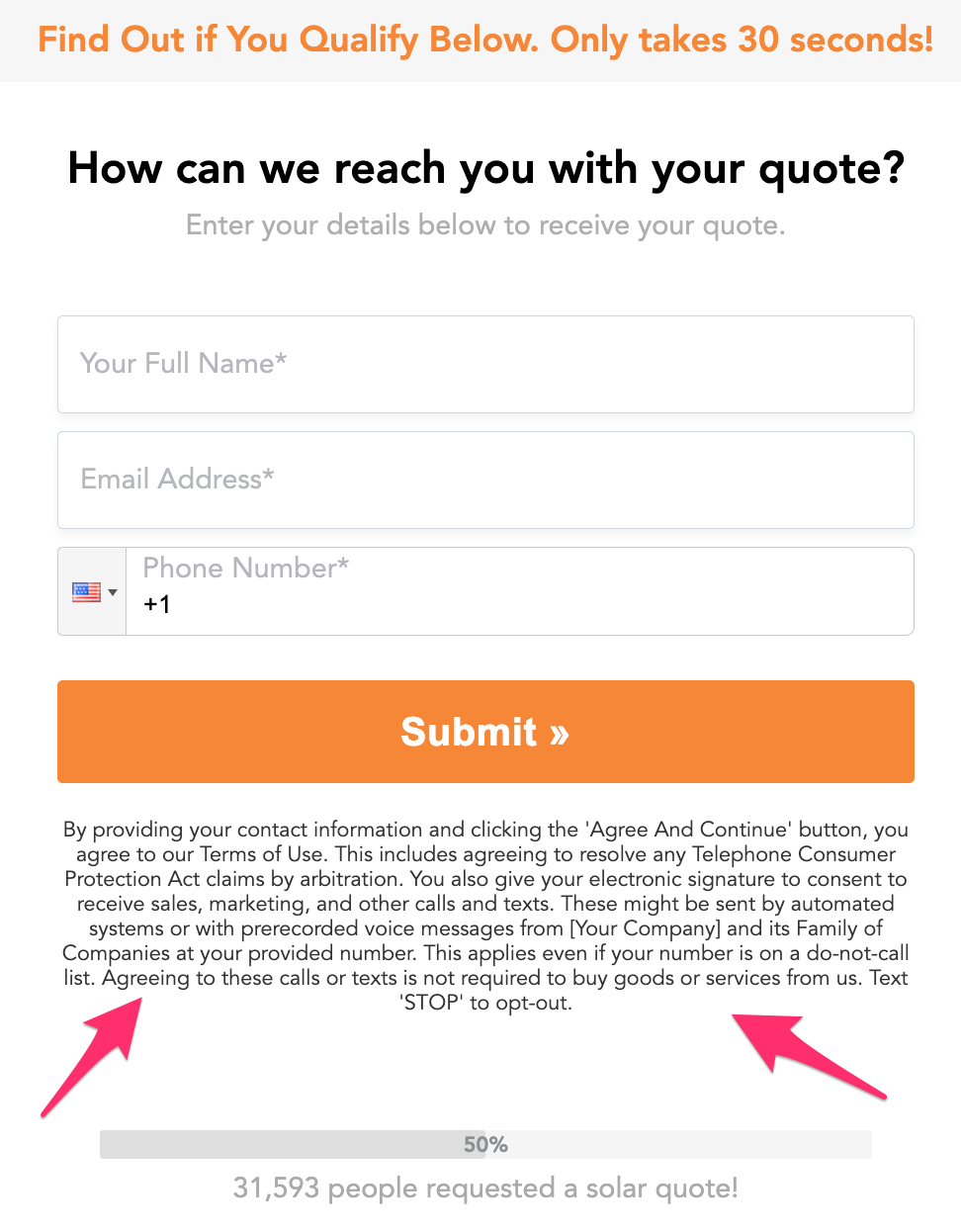
I’ll be sharing more examples throughout this content. In the meantime, you can grab this exact lead form template with TCPA compliance opt-in text here.
Your best protection when capturing leads: Prior express written consent
Consent is the number one thing you need when capturing leads. The strongest form you can secure is prior express written consent.
But don’t worry about getting buried with thousands of physical documents when collecting consent.

“Written” can be electronic. In other-words, you don’t have to deliver a physical piece of mail and ask for your lead’s signature in person. Let’s talk about it more below.
What does consent look like?
Express written consent is like a ‘go signal’ given by your customers.
It’s a simple action they take, such as ticking a checkbox on your web form that says, “Yes, I’m okay with you contacting me through call and text.”
This checkbox should be close to their contact details or the submit button on your form. Like this sample below:

Remember that this is a written agreement. So, pre-tick checkboxes don’t equate to actual consent. Adding them to your form is like signing the papers for your clients, which doesn’t represent their choice.
It must be clear that they permit your company to send marketing communications.
Prior express written consent also has a significant advantage – it can override the National Do Not Call list.
Express written consent reduces issues on your part and boosts your conversion rate by letting you connect with people who are genuinely interested in your messages.
Now, onto the checklist.
What’s on our TCPA consent compliance checklist?
When it comes to ensuring your lead forms are TCPA compliant, there are specific elements you must include. We’ve broken down these elements into six key areas:
1. Make it clear to the consumer what will happen if they submit your form
Your leads should fully understand what to expect after signing up on your forms. The more detailed it is, the better.
Just look at this example from Rocket Mortgage’s statement highlighting its TCPA compliance policy. 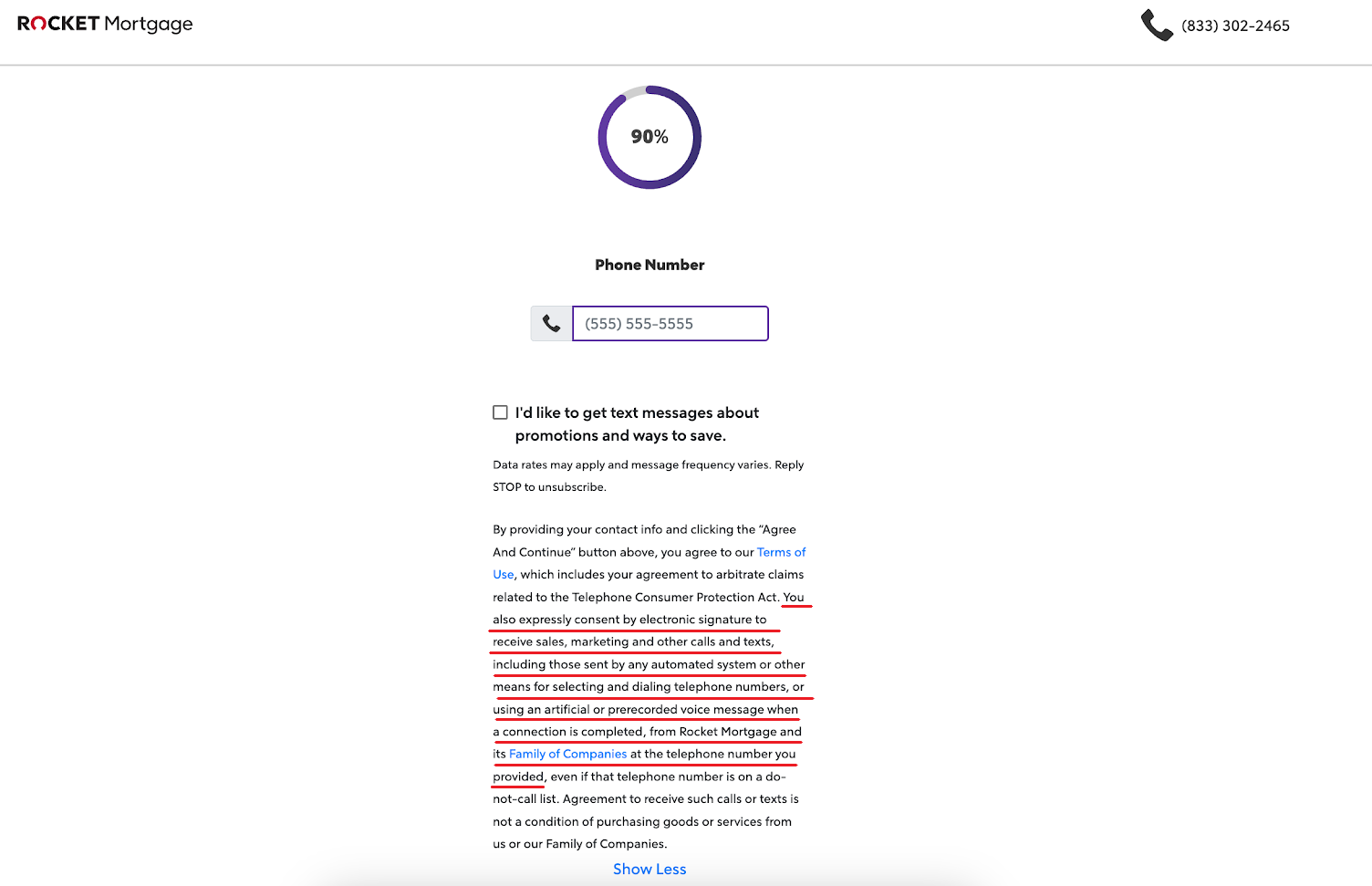
RocketMortgage has done a great job of including all there’s to know in less than 150 words. It consists of the type of content they’ll receive, who will send the promotional messages, and what they can do to stop receiving them.
In addition, they added links for those areas that may need more details, such as the Terms of Use.
Here’s a text template for your forms:
“By providing your contact information and clicking the ‘Agree And Continue’ button, you agree to our Terms of Use. This includes agreeing to resolve any Telephone Consumer Protection Act claims by arbitration. You also give your electronic signature to consent to receive sales, marketing, and other calls and texts. These might be sent by automated systems or with prerecorded voice messages from [Your Company] and its Family of Companies at your provided number. This applies even if your number is on a do-not-call list. Agreeing to these calls or texts is not required to buy goods or services from us. Text ‘STOP’ to opt-out.”
2. The terms and conditions are clear and easy to understand (no “legalese”)
Legalese is a writing style that uses technical terms and complex languages. It’s often used in legal documents.
When it comes to your lead forms, using legalese can confuse your leads, and that’s the last thing you want. It’s better to stick with plain, easily understandable language.
A perfect example is this Ecowatch form.

It starts with a clear statement and even used common words to explain that providing your phone number and details is voluntary.
EcoWatch also doesn’t use jargon that an average person wouldn’t understand.
If you want to use something similar, you can check and tweak this template:
“By submitting the form above, I consent to be contacted about my service request and [include other services or offers] by our Trusted Partners. The contact may be via telephone, call, or text message, including an automatic telephone dialing system or prerecorded or artificial voice message. Giving this consent is not a condition of any purchase. Message and data rates might apply when contacted. By using this service, I agree to the Terms of Service and Privacy Policy.”
P.S. Do you want to create a well-designed, TCPA-compliant form in just a few minutes? You can do that with GetLeadForms. Our forms are beginner-friendly and offer many features you’d love.
3. The disclosure statement is clearly visible in the immediate vicinity of the opt-in button
Your written agreement should be available right where leads are about to give their consent.
This positioning aligns with TCPA opt-in requirements, where necessary information is transparent and accessible. It makes it hard for anyone to miss. And you must apply whether you’re using a single-step or a multi-step form.
The best placement is always near the last step or submit button.
Check out what Afiac did:
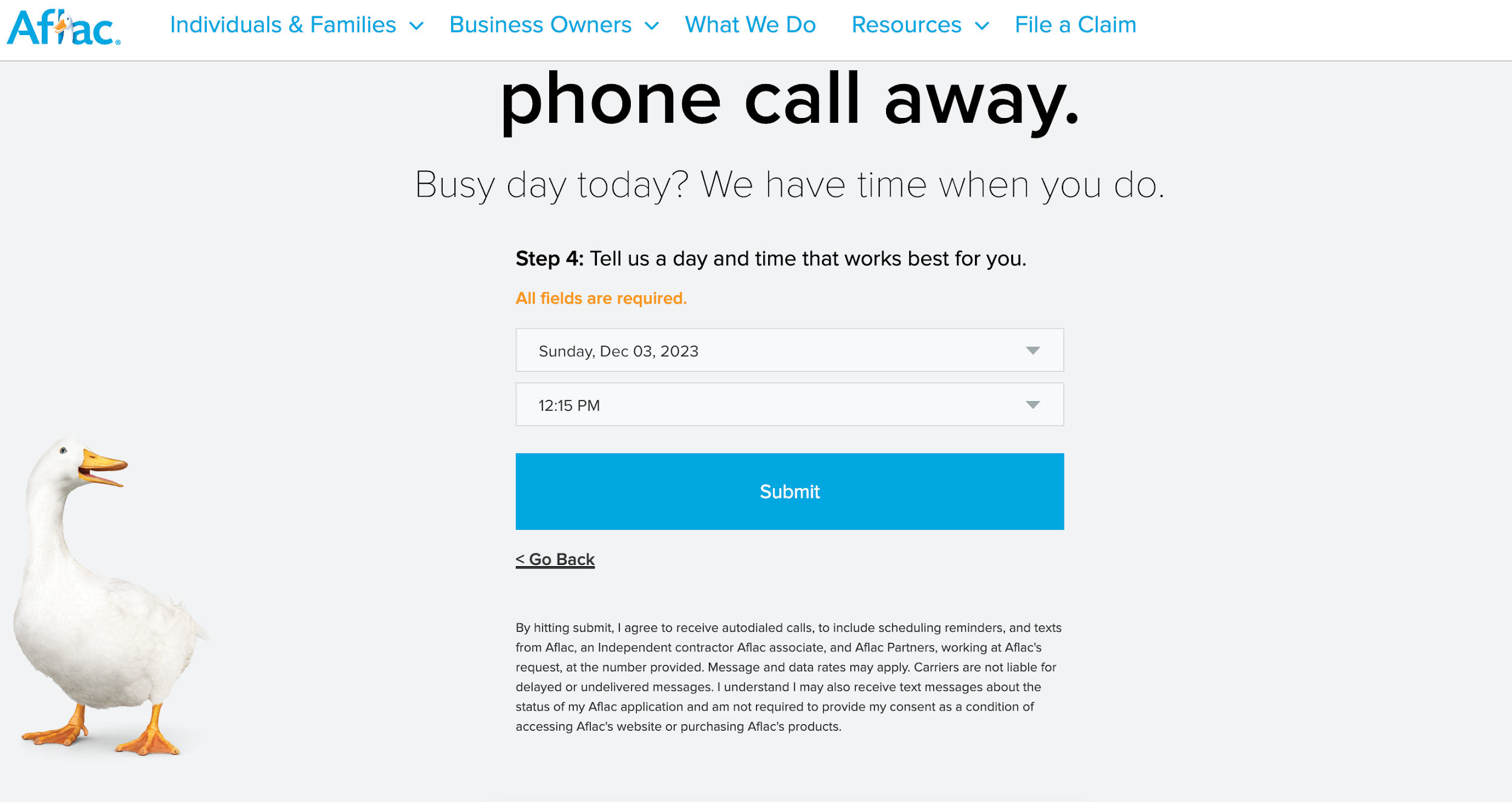
Here’s a similar template that you can use:
“By hitting submit, I agree to receive autodialed calls, to include scheduling reminders, and texts from (insert company name) and(insert company name) partners, working at (your company name) request, at the number provided. Message and data rates may apply. Carriers are not liable for delayed or undelivered messages. I understand I may also receive text messages about the status of my (company name) application and am not required to provide my consent as a condition of accessing (company name) website or purchasing (company name’s) products.
4. The disclosure statement provides the company’s identity that will contact the consumer
How would you feel if you had to submit a form and had no idea who would contact you? Would you still feel comfortable providing your details?
For businesses in pay-per-lead or lead buying, this aspect is essential. Your statement should state your company’s identity.
It reassures leads, letting them know who they share their information with and who will reach out. Clear identification in your forms builds comfort and trust from the outset.
Take this sample form from Sotheby’s International Realty Agency as an example:
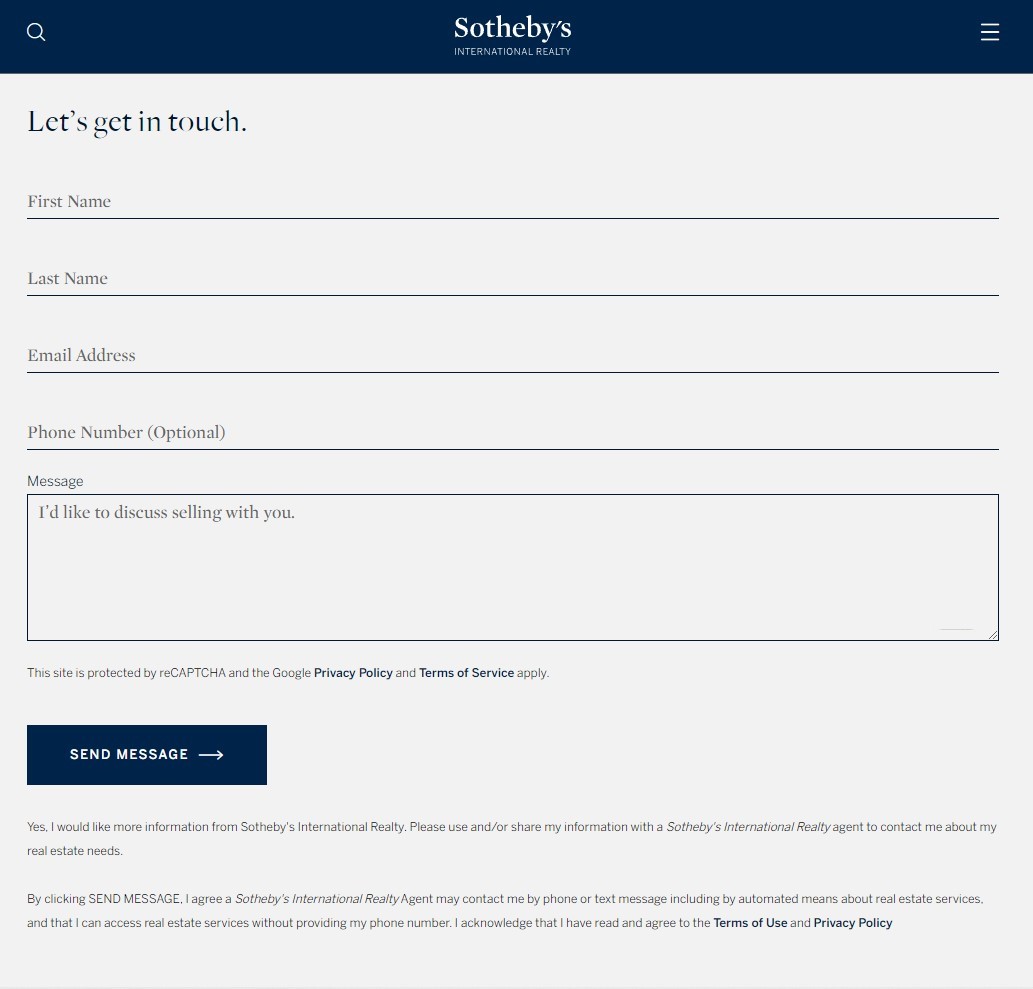
They made sure to mention their company’s name multiple times. Their form also follows prior items on this checklist.
You can use this template to create your own disclosure statement:
“By completing this form, I consent to be contacted by [Your Company] about relevant services. This contact may include phone calls or text messages, possibly through automated means. I am aware that I can opt to access services without providing my phone number. I confirm that I have read and agreed to the Terms of Service and Privacy Policy.”
5. Clearly state in the disclosure statement if calling or communicating with the lead via SMS
If your strategy includes following up with prospects via SMS or automated text messaging, your disclosure statement should reflect this. This transparency ensures that your leads are fully aware and have agreed to this type of communication.
You can also consider phone verification for an added layer of protection on your part and your leads. In GetLeadForms, we have our OTP phone verification feature, which enhances the reliability of the consent process. Learn more about it in this post.
Here’s a great example from Tribeca.

It’s already a solid form. However, if I can add one thing, I’ll include the frequency of marketing messages so that my leads have a complete picture of what to expect.
These are some key points you should keep in mind:
- State the Communication Method. Mention if you will use SMS or an automated communication dialing system.
- Disclose Pre Recorded Calls. If you plan to use pre recorded calls, state this explicitly in the disclosure.
- Specify Communication Frequency. Inform the consumer about the approximate number of calls and texts they might receive.
You can use this template as your guide:
“By submitting your cell phone number, you agree to receive marketing messages from [Your Company] through voice calls, AI-generated calls, text messaging, or other automated methods. We’ll limit our contact to no more than [specific number] times each month. Details on how we use your information are available in our Privacy Policy.”
6. Ensure that you are properly capturing and storing proof of consent.
The last one on our checklist plays a huge role if someone tries to challenge your compliance practices.
Marketers and lead generators like you must accurately capture and securely store this consent. This information should seamlessly integrate into your CRM when someone agrees to your terms.
That way, you can provide proof to your lead buyers and stay clear of compliance issues. Here are some things you can do to record your written agreement correctly.
- Proof of Consent: Ensure you can show that the consumer agreed by checking the box or completing the form.
- Visual Record of Consent: Use a session replay solution to keep a visual record of the TCPA language seen by the consumer and their action of giving consent. This includes filling in information, checking the box, and hitting “Submit.”
- Third-Party Storage: Store your consent records with a reliable third party to ensure the data is secure and untampered.
- Accessibility and Shareability: Your documentation should be easy to access and share when needed.
- Regular Audits: Conduct spot checks on your consent documentation to guarantee accuracy and reliability.
- Consent Matching for Purchased Leads: If you buy leads, match the consent document with each lead. Verify that the lead has consented before calling or sending a text message.
Integrating Active Prospect’s Trusted Form with your lead forms offers clear proof of consent.
It generates a certificate for each lead, providing unbiased evidence that the lead requested contact and valuable real-time insights about the lead.
The TrustedForm Cert looks something like this:
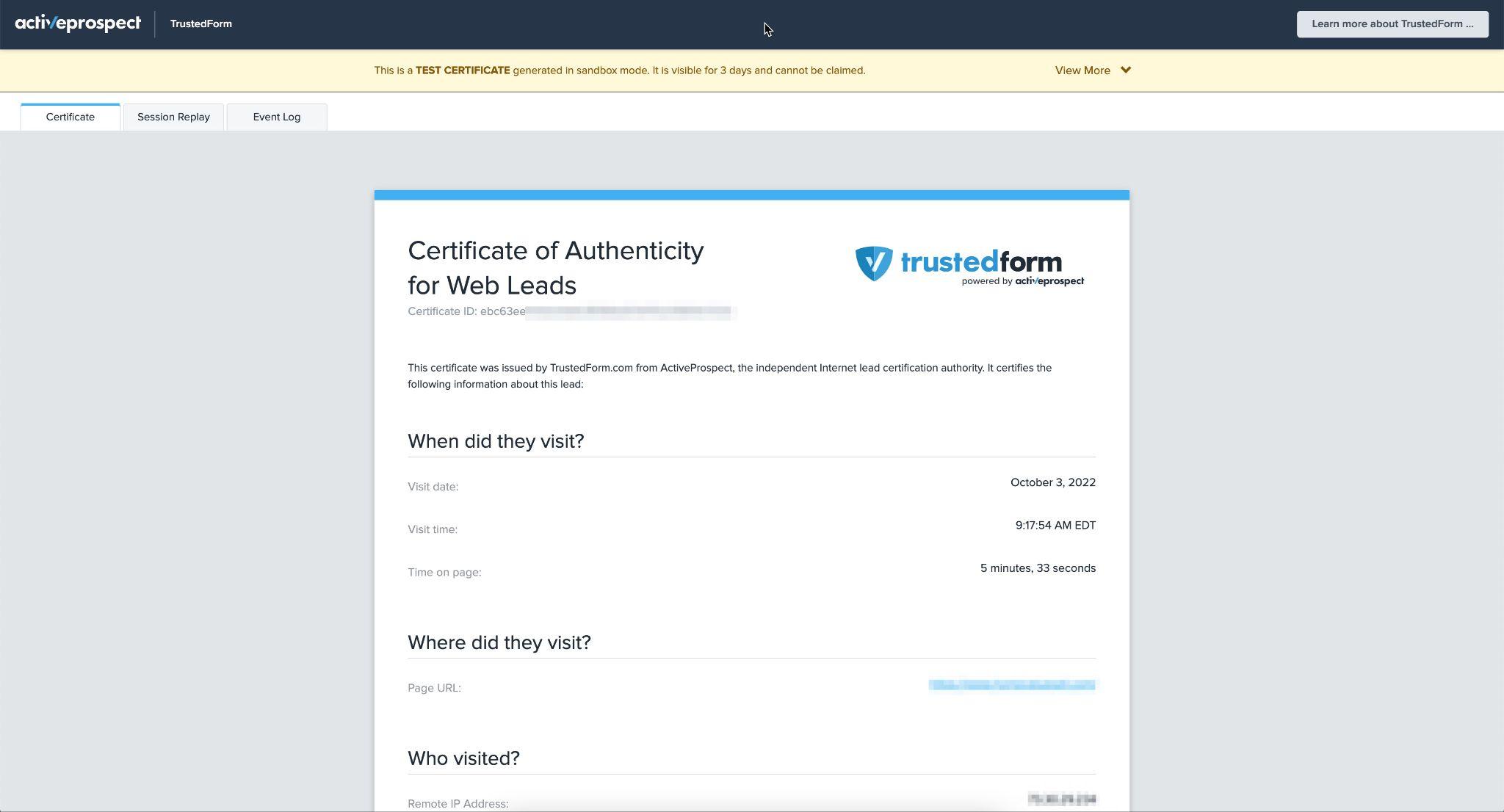
Note: GetLeadForms integrates with TrustedForm to help you easily capture consent in your forms. Learn more about our Trusted Form Integration.
Next steps: Review your form’s TCPA-opt-in text
That’s it for this comprehensive TCPA compliance checklist!
I know this is a TON to take in, but it really comes down to prepare a clear, detailed, and documented consent.
As a next step: I’d recommend reviewing your form’s TCPA compliance text against some of the recommendations and templates provided in this document.
If you’re using forms built with GetLeadForms, you can easily add or update your TCPA Opt-in text in our TCPA section of your form:
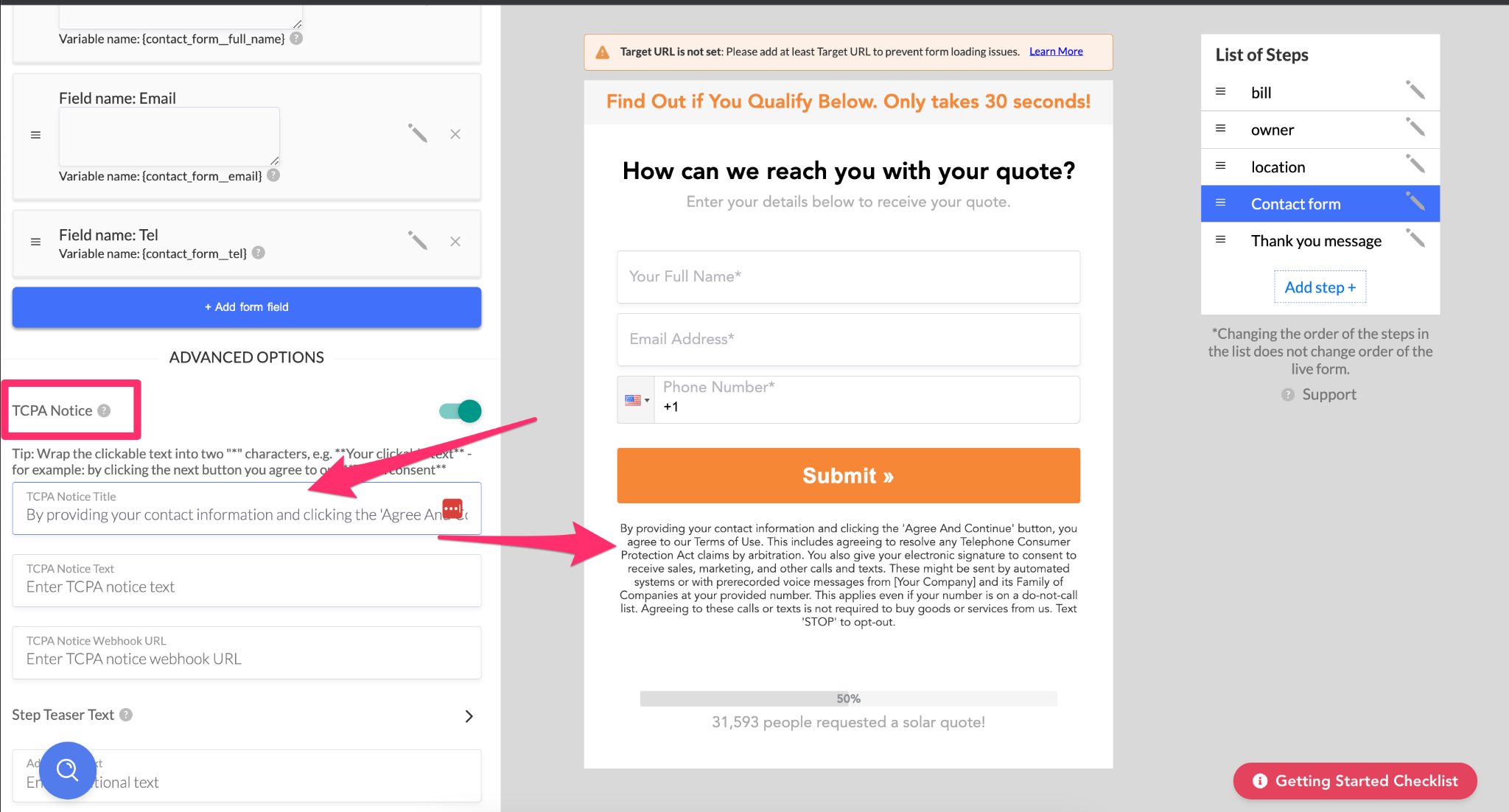
If you need help adding TCPA opt-in text to your form and passing the consent text into your CRM, you can grab a free trial of GetLeadForms here.
Here are some resources that you might find helpful:
- An example LeadForm template with TCPA Opt-in text setup and ready to go: Check out the template
- How to Setup ActiveProspect TrustedForm With Your LeadForm to Certify Your Lead’s Consent (3 Easy Steps): Read the post

